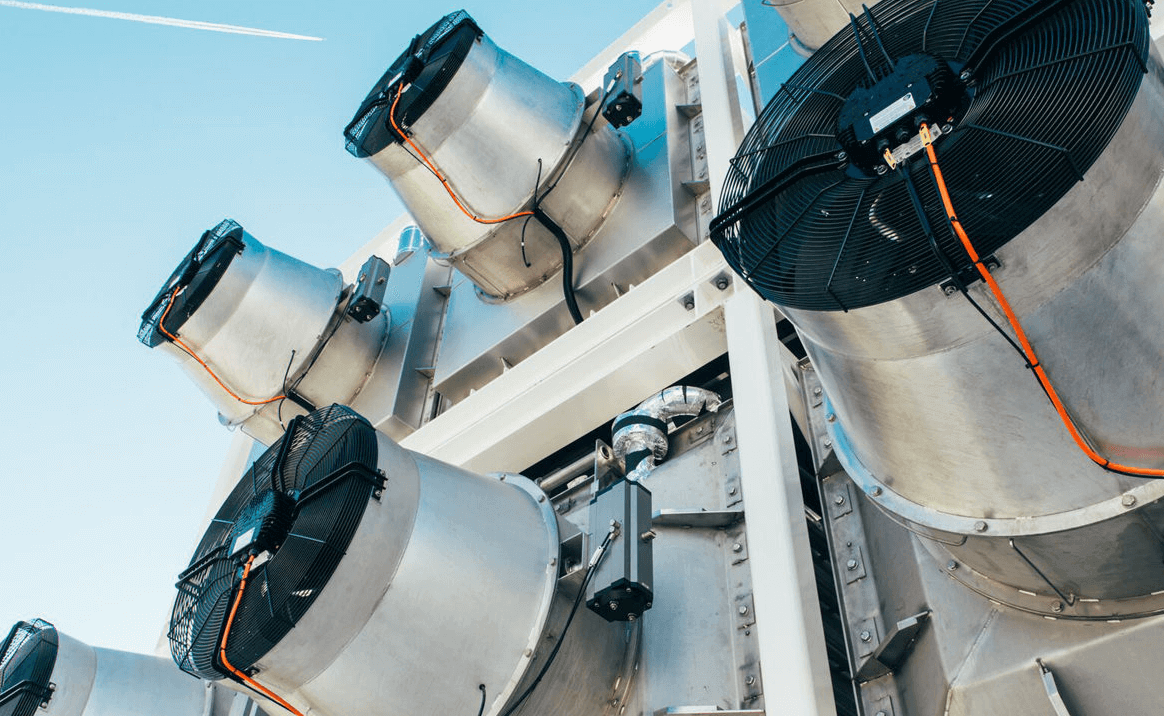Carbon Capture & Storage

Image: Climeworks Direct Air Capture plant, Switzerland. Credit: © Climeworks / Julia Dunlop
What is the challenge?
Global economy-wide decarbonization is required to meet the Paris Agreement target of limiting warming to 1.5 degrees by mid-century. Different sectors of the economy have vastly different exposure to this global transition to net-zero emissions. What a net zero transition entails for a technology company, for example, is very different to what it means for a natural gas power plant or cement manufacturer that have ‘hard to abate’ emissions and for which the transition to zero emissions may not be nearly so straightforward. GHG emissions are embedded in their processes, viable alternatives may not yet exist or may take time to implement, and abatement is often cost prohibitive. Hard to abate sectors include buildings and transportation (automobiles, aviation and maritime shipping) and essential industrial sectors – such as chemicals, steel and fertilizer production – which often require high heat for their processes and for which there are currently few alternatives for the direct use of fossil fuels.
The energy sector is another such hard to abate sector. While deep decarbonization and a rapid transition to renewable energy sources is critical to global climate action, there are realities that will impose certain limitations on the pace of this transition. For example, even as countries shift to renewable energy sources, due to existing infrastructure, many emissions from the energy sector are already locked-in for the next few decades. In regions like Europe and China, existing commitments and increasing energy demand in financial capital and construction demonstrate that fossil-fuel generated power plants will continue to play an outsized role in the sector between now and 2050.
What is the solution?
Carbon capture and storage (CCS) provides a technology-based solution to address industrial carbon emissions that are currently challenging or cost prohibitive to abate.
The CCS process works by capturing carbon dioxide produced in concentrated waste streams at industrial facilities and fossil fuel-generated power plants. The captured carbon is then transported and injected into secure, deep underground geological formations. The Intergovernmental Panel on Climate Change (IPCC) that a power plant equipped with CCS can reduce carbon emissions to the atmosphere by at least 80 to 90 percent compared to a plant without CCS. CCS equipped power plants can also supply flexible low-carbon electricity.
Additional approaches, Direct Air Capture (DAC), Bioenergy with CCS (BECCS), Biomass with Carbon Removal and Storage (BiCRS) can support the acceleration of net carbon removal. Rather than being linked to an industrial point source of carbon, DAC captures carbon dioxide directly from the air. This technological advantage allows DAC facilities to be co-located with storage reservoirs, which could reduce the cost of transporting captured carbon to storage locations and allow accessibility to low carbon energy sources to power the equipment.
BECCS is a process by which emissions from bioenergy, which are created by burning biomass, are reduced through carbon removal and storage. BiCRS captures CO2 from biomass combustion or other concentrated carbon removed from the atmosphere by biomass and combines this with carbon capture technology and geologic storage. This suite of technologies offers opportunities for negative carbon emissions when using sustainable biomass. Sustainable biomass is defined in our methodology (below) as being derived from forestry, agricultural, or municipal waste or as an energy crop cultivated on marginal or degraded land. Biomass that contributes to an increase in food prices by displacing food crops is not eligible.
Research from both the IPCC and the International Energy Agency (IEA) has shown that CCS is a critical tool to reach net-zero emissions by 2050. According to the IPCC, all pathways that limit global warming to 1.5C project the use of carbon dioxide removal in addition to emissions reduction policies. It presents three scenarios for achieving this goal that involve major use of CCS. The scenario that does not utilize CCS requires the most immediate and dramatic shift in human behavior. The role of CCS implicit in the IPCC report is somewhere between 350 and 1200 gigatonnes of CO2 that needs to be captured and stored this century.
In 2020, 26 global CCS facilities supported the capture of 40 million tons of carbon dioxide. Estimates suggest that to meet the UN’s target, CCS capacity will need to increase from its current levels of around 40 million tonnes per annum (Mtpa) to over 5,600 Mtpa by 2050. To facilitate this exponential growth, the industry will require between $655 billion and nearly $1.3 trillion in capital investment.
ACR’s methodology
ACR’s methodology for the Quantification, Monitoring, Reporting, and Verification of Greenhouse Gas Emissions Reductions and Removals from Carbon Capture and Storage Projects v2.0 – will support an expanded variety of CCS projects. As private companies continue to signal strong interest in technology-based solutions, this methodology will provide a framework for both project developers and carbon market buyers interested in high quality CCS emission reductions and removals towards their climate targets.
The methodology outlines the requirements for the creation of carbon credits by CCS project developers including eligibility, ownership, regulatory compliance and rigorous monitoring, reporting, and verification during active project operation as well as post-project to ensure permanent carbon storage.
Eligible carbon dioxide sources include power plants that burn biomass, coal, natural gas, or oil and industrial facilities such as petroleum refineries, oil and gas production facilities, iron and steel mills, cement plants, fertilizer plants, ethanol distilleries and chemical plants. The methodology will also expand point source CO2 eligibility to direct air capture and storage options to include saline formations and depleted oil and gas reservoirs.
Additional benefits
Carbon finance will also catalyze job growth in the industry, creating opportunities for workers in the fossil fuel industry to transition to high value positions. Estimates suggest that investments in the installation and construction of carbon capture facilities could create up to 64,000 jobs within the next 15 years, and an additional 43,000 jobs could be generated for maintenance and operations.